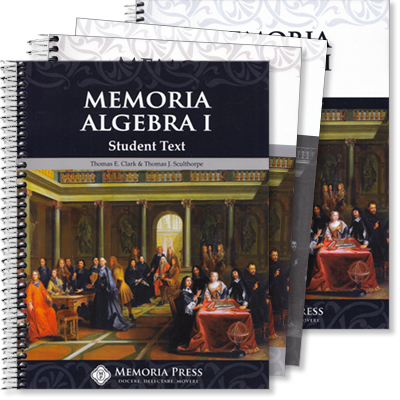
Memoria Algebra I Set
- 7.588 lbs
Item #56-M-1--
| This set includes: | # in My Cart | ||
|---|---|---|---|
| Student Textbook | $45.00 | ||
| Quizzes and Tests | $20.00 | ||
| Solutions Key | $40.00 | ||
| Teacher's Manual | $45.00 | ||
| This set includes: 4 items | |||
Second book in the Memoria Algebra Series.
Memoria Algebra I continues to build mastery of the mathematical discipline of algebra. It picks up right where Memoria Pre-Algebra leaves off, starting with first-degree relations with two and three variables and moving on to higher-degree and rational relations.
If you completed a different pre-algebra course, you can still pick up with Memoria Algebra I if you learned first-degree equations and inequalities with one variable, including solving and graphing compound inequalities and absolute value relations and using single-variable equations to solve word problems. A sound foundation in these topics, as well as in algebraic terminology and symbolism, is necessary as this is a fast-paced and challenging course.
You will complete your mastery of first-degree relations by learning solving and graphing skills for two or more variables, and then you will transition to higher-degree relations involving polynomial operations and factoring, algebraic fractions and rational functions, and radical expressions and equations. The course culminates in the broadening of your conception of a legitimate number by introducing the imaginary number and the set of complex numbers. You will need to match the rigor of the course content with your own rigor and diligence in memorization and recitation, exercise completion and correction, and successful completion of the assessments. This course is the necessary prerequisite for Memoria Algebra II [still in development].
The Student Text's primary features, besides providing problem banks with which students can work toward mastery, include clear statements of lesson objectives, introduction and review of important terms, and detailed consideration of example problems. Ensure that students master the terms and utilize the examples as the main instructional tool as they move toward completing exercises independently. The first couple exercises can be used for further demonstration as required. All exercises should be completed, checked for accuracy, and corrected for each lesson, and problematic exercises can be repeated for mastery. An answer key for the odd exercises is included in the Appendix. Ensure that students have met the lesson objective before moving on.
The Quizzes & Tests is used to evaluate student progress. Often open-response questions are utilized that require students to state, in writing, their understanding of the concept under examination. This is an invaluable skill that ensures that students understand the mathematical concepts they are learning rather than becoming mere computers. Throughout this course, there are multiple quizzes, one at the conclusion of each part, and a test at the conclusion of each unit. Quizzes focus on the material in their respective parts, but exams are cumulative. There is also a Final Exam that should be attempted after intensive review. Mastery of the material presented in this course should translate to a score of 85 or greater on the Final Exam. Reserve Form B assessments for retakes or for Final Exam review in the closing weeks of the course.
The Teacher Manual serves as the primary instructional resource for the course and includes an answer key for all lesson exercises. Before presenting a lesson to students, thoroughly review the material and the teacher notes for helpful techniques and emphases. A teacher or homeschool instructor with an elementary understanding of algebra will be able to convey the lesson concepts and achieve the lesson objectives by understanding and following the material included in the Teacher Manual.
The Solutions Key contains complete, detailed solutions for every exercises to ensure comprehension.
A recitation schedule is located in the Appendix of the Student Text and Teacher Manual. Students should master the responses to the recitation questions for each lesson, reviewing recitation questions as necessary until they are mastered.
Contents
- Introduction
Unit I: First-Degree Relations with Two Variables
Part A: The Solution Set for One Open Sentence
- 1. Graphing Terminology
- 2. Solution Sets for Equations
- 3. Solution Sets for Inequalities
- 4. Graphing Techniques for y = mx
- 5. Graphing Techniques for y = mx + b
- 6. Graphing Techniques - Intercepts
Part B: Special Case Solution Sets
- 7. Horizontal Lines
- 8. Vertical Lines
- 9. Absolute Value
Part C: Determining Relations for Given Solution Sets
- 10. Given the Slope and y-Intercept
- 11. Given the Slope and One Solution
- 12. Given Two Solutions
- 13. Special Cases - Parallel or Perpendicular Lines
Part D: Solution Sets for Systems of Two Open Sentences
- 14. Graphic Solutions for Systems of Equations
- 15. Graphic Solutions for Systems of Inequalities
- 16. Algebraic Solutions for Systems of Equations - Elimination by Addition
- 17. Algebraic Solutions for Systems of Equations - Elimination by Substitution
Part E: Special Cases of Solution Sets for Systems of Two Open Sentences
- 18. No Solution - Inconsistent
- 19. Infinite Number of Solutions - Dependent
Part F: Problem Solving Using Two Variables
- 20. General Strategy and Set-Up
- 21. Number Problems
- 22. Age Problems
- 23. Geometric Figure Problems
- 24. Motion Problems
- 25. Percent Problems
- 26. Value or Mixture Problems
Unit II: First-Degree Relations with Three or More Variables
Part A: Solution Sets for Relations with Three Variables
- 27. One Open Sentence with Three Variables
- 28. Two Open Sentences with Three Variables
- 29. Systems of Three Open Sentences with Three Variables
Part B: Special Case Solution Sets
- 30. No Solution - Inconsistent
- 31. Infinite Number of Solutions - Dependent
Part C: Problem Solving Using Three or More Variables
- 32. Number Problems
- 33. Age Problems
- 34. Geometric Figure Problems
- 35. Value or Mixture Problems
Unit III: Higher-Degree Relations - Polynomials
Part A: Exponent Notation
- 36. Exponent Definitions and Terminology
- 37. Operations with Powers
- 38. Simplifying Powers
- 39. Special Cases of Powers
- 40. Scientific Notation
Part B: Polynomials
- 41. Terminology - Algebraic Expressions
- 42. Terminology - Polynomials
- 43. Polynomial Operations - Addition & Subtraction
- 44. Polynomial Operations - Multiplication
- 45. Polynomial Operations - Division
Part C: Solving Polynomial Relations
- 46. Principle of Zero Products
- 47. Special Products - Common Factor
- 48. Special Products - Difference of Squares
- 49. Special Products - Trinomial Square
- 50. Special Products - Sum of Difference of Cubes
- 51. General Trinomial
- 52. Four-Term Polynomial
- 53. General Factoring Strategy
- 54. Synthetic Division
- 55. Formulas
Part D: Problem Solving with Polynomial Relations
- 56. Number Problems
- 57. Consecutive Integer Problems
- 58. Geometric Figure Problems
- 59. Formula Problems
Unit IV: Higher-Degree Relations - Algebraic Fractions
Part A: Operations with Algebraic Fractions
- 60. Simplifying Algebraic Fractions
- 61. Multiplying Algebraic Fractions
- 62. Dividing Algebraic Fractions
- 63. Adding and Subtracting Algebraic Fractions
- 64. Complex Algebraic Fractions
Part B: Solving Relations Containing Algebraic Fractions
- 65. Equations with Numerical Denominators
- 66. Equations with Algebraic Denominators
- 67. Inequalities with Algebraic Denominators
- 68. Formulas with Algebraic Fractions
- 69. Graphs of Rational Functions
Part C: Problem Solving with Algebraic Fractions
- 70. Fraction Problems
- 71. Work Problems
- 72. Motion Problems
- 73. Direct Variation Problems
- 74. Inverse Variation Problems
- 75. Mixed Variation Problems
Unit V: Rational Degree Relations
Part A: Radical Notation
- 76. Rational Exponents and Radical Notation
- 77. Odd and Even Radical Indices
Part B: Operations with Radical Expressions
- 78. Multiplying Radical Expressions
- 79. Simplifying Radical Expressions
- 80. Dividing Radical Expressions
- 81. Adding and Subtracting Radical Expressions
- 82. Radical Expressions as Polynomials
- 83. Rationalizing Radical Denominators
Part C: Solving Radical Equations
- 84. Equations with One Radical
- 85. Equations with Two or More Radicals
- 86. Graphs of Radical Functions
Part D: Problem Solving with Rational Degree Relations
- 89. Imaginary Complex Numbers
- 90. Adding and Subtracting Complex Numbers
- 91. Multiplying Complex Numbers
- 92. Dividing Complex Numbers
Appendix
- Recitation
- Memoria Algebra I Readiness Exam
- Memoria Algebra I Readiness Exam - Key







![Grade 3 Math [3rd Edition] Workbook 4](http://www.milestonebooks.com/xcart/var/images/product/160.160/1-133244.jpg)
![Grade 3 Math [3rd Edition] Workbook 3](http://www.milestonebooks.com/xcart/var/images/product/160.160/1-133234.jpg)
![Grade 3 Math [3rd Edition] Workbook 2](http://www.milestonebooks.com/xcart/var/images/product/160.160/1-133224.jpg)
![Grade 3 Math [3rd Edition] Workbook 1](http://www.milestonebooks.com/xcart/var/images/product/160.160/1-133214.jpg)